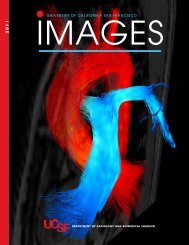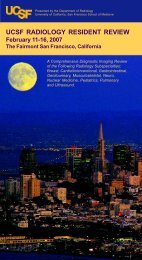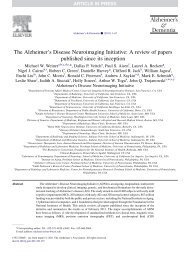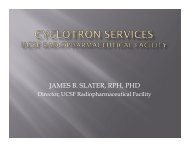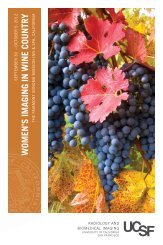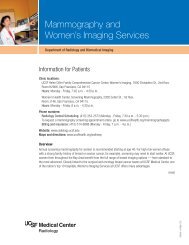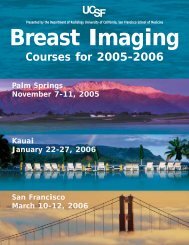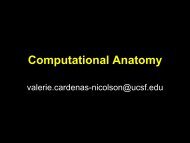6th International Workshop on Breast Densitometry and Breast ...
6th International Workshop on Breast Densitometry and Breast ...
6th International Workshop on Breast Densitometry and Breast ...
- No tags were found...
You also want an ePaper? Increase the reach of your titles
YUMPU automatically turns print PDFs into web optimized ePapers that Google loves.
6 th <str<strong>on</strong>g>Internati<strong>on</strong>al</str<strong>on</strong>g> <str<strong>on</strong>g>Workshop</str<strong>on</strong>g> <strong>on</strong> <strong>Breast</strong> <strong>Densitometry</strong><br />
<strong>and</strong> <strong>Breast</strong> Cancer Risk Assessment<br />
P32 APPLICATION OF SHAPE AND APPEARANCE MODEL APPROACH TO<br />
MAMMOGRAMS<br />
Serghei Malkov 1 , Karla Kerlikowske 2 John A. Shepherd 1<br />
1 Department of Radiology <strong>and</strong> Biomedical Imaging, University of California, San Francisco, 1 Irving<br />
Street, Suite AC108, San Francisco, CA 94143-0628 ; 2 Departments of Medicine <strong>and</strong><br />
Epidemiology/Biostatistics, University of California, San Francisco, 1635 Divisadero Street, Suite 600,<br />
San Francisco, CA 94115<br />
Abstract: The extracti<strong>on</strong> of new informati<strong>on</strong> from clinical breast mammograms could help to improve<br />
breast cancer risk assessment techniques. The image shape <strong>and</strong> texture estimati<strong>on</strong> (appearance) designed<br />
for face recogniti<strong>on</strong> seems to be promising approach for applicati<strong>on</strong> in breast imaging.<br />
Purpose: The purpose of this study is to apply a shape <strong>and</strong> appearance model approach to digital<br />
mammograms. Potentially, the breast shape <strong>and</strong> appearance model parameters could give new informati<strong>on</strong><br />
valuable for breast density estimati<strong>on</strong>, breast cancer risk assessment <strong>and</strong> diagnostics.<br />
ABSTRACTS<br />
Materials <strong>and</strong> Methods: We built a shape <strong>and</strong> appearance model using 200 full field digital<br />
mammograms with calculated percent fibrogl<strong>and</strong>ular volumes (%FGV) from San Francisco<br />
Mammography Registry. The model approach was implemented according to the method of Cootes et al<br />
[1]. To build the shape model, we used the edge <strong>and</strong> grid point coordinates inside of the breast area. A<br />
Procrustes transformati<strong>on</strong> was used to remove rotati<strong>on</strong>, translati<strong>on</strong> <strong>and</strong> scale. A Principal Comp<strong>on</strong>ent<br />
Analysis (PCA) was applied to extract significant <strong>and</strong> uncorrelated comp<strong>on</strong>ents. In order to build an<br />
appearance model, first, we transformed the breast images into the mean texture image by piecewise<br />
linear image transformati<strong>on</strong>. That step aligned all texture informati<strong>on</strong> inside the reference mean image.<br />
Then, the image pixels grey-scale values are c<strong>on</strong>verted into a set of significant principal comp<strong>on</strong>ent<br />
vectors. Finally, the shape <strong>and</strong> texture feature sets of each image are created using principal comp<strong>on</strong>ent<br />
vectors. In additi<strong>on</strong>, to remove shape <strong>and</strong> texture correlati<strong>on</strong>s another PCA transform was applied to get a<br />
combined shape-appearance model. The stepwise regressi<strong>on</strong> with forward selecti<strong>on</strong> <strong>and</strong> backward<br />
eliminati<strong>on</strong> was used to estimate the outcome %FGV with shape <strong>and</strong> appearance features <strong>and</strong> other<br />
parameters including age, bmi, thickness, mAs <strong>and</strong> force.<br />
Results: We obtained the maps <strong>and</strong> pixel distributi<strong>on</strong>s of different shape <strong>and</strong> appearance PCA<br />
comp<strong>on</strong>ents. The shape <strong>and</strong> appearance scores are found to correlate moderately to breast %FGV, dense<br />
tissue <strong>and</strong> actual volumes, bmi <strong>and</strong> age. The highest Pears<strong>on</strong> correlati<strong>on</strong> coefficient is equal 0.76 for the<br />
first shape PCA comp<strong>on</strong>ent <strong>and</strong> actual breast volume. The stepwise regressi<strong>on</strong> of the outcome %FGV<br />
from shape <strong>and</strong> appearance variables, thickness, age, mAs <strong>and</strong> force, met the 0.01 significance level for<br />
entry into the model during forward selecti<strong>on</strong>, dem<strong>on</strong>strated R-square around 0.8. Eleven significant<br />
variables were selected by regressi<strong>on</strong> am<strong>on</strong>g 185 parameters.<br />
C<strong>on</strong>clusi<strong>on</strong>: We applied the shape <strong>and</strong> appearance model approach to mammograms <strong>and</strong> dem<strong>on</strong>strated its<br />
feasibility to extract a new set of variables. Further exploring <strong>and</strong> testing of this approach is necessary.<br />
References:<br />
T.F. Cootes, G.J Edwards, <strong>and</strong> C,J. Taylor "Active Appearance Models", IEEE Transacti<strong>on</strong>s <strong>on</strong> Pattern<br />
Analysis <strong>and</strong> Machine Intelligence 2001<br />
67



